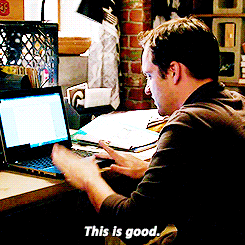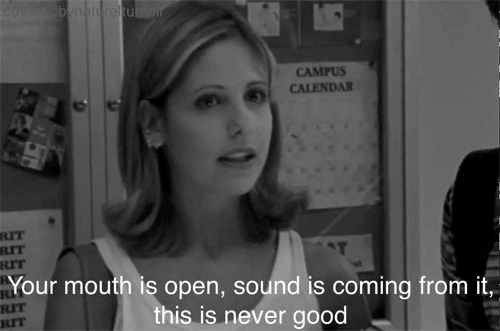#chopped”? The comma is telling you something very important. The way to fix it is with the comma telling you to first measure the ingredien
Explore tagged Tumblr posts
Text
What Did You Say? A guide to writing good dialogue
(Remember all pieces of advice are meant to help guide, that is all. They are not dogma.)
Ever read something and heard the dialogue in your head, and you just stopped. There was something off about it and for a solid minute there you couldn’t tell if the character was supposed to sound like that or if the author just didn’t have dialogue down. Chances are some mistakes were made.
Dialogue can be tricky. There’s no doubt about it.
You need to make it sound like the characters are having a real conversation but if you write it exactly like people talk it can get confusing and sound even worse.
“So how do I write good dialogue?!”
You can usually sense when your dialogue needs work. So here’s a set of some dialogue trick that might help you. When you think something is off with your dialogue use this to help you figure out what and make some changes.

All about that Flow-
It’s said all the time about your first draft, the important thing is to get the words on the page, you’ll refine later. This technique applies to your dialogue, and you’ll even come up with lines you never would have if you spent your time trying to be perfect.
You can even try writing the dialogue first. Get down what your characters are arguing about, planning, revealing, etc. Do it fast, pay no attention to who said what. Just get the words out.
This dialogue can give you a good idea what the scene is about and it might be different than what you thought. Then just go back to it and fill in.
This can be good for when you’re in a slump.
Talk it Out-
You can also practice dialogue or get yourself going by speaking the lines of two of your characters as they interact. An argument or conversation between your two character except you say all the lines as they come to you.

Overt the Obvious-
A very common mistake is creating a simple back-and-forth. Each line directly answers the previous line, often repeating a word or phrase from that previous line, echoing it. Ex:
“Hello, Tina.” “Hi, Jane.” “I really like your blouse.” “Oh, my blouse! You mean this old thing?” “Old thing! You’ve never worn it before.”
No surprises and very little interest. Some direct response is alright, but your dialogue will be better if you overt the obvious:
“Hello, Tina.” “Jane. I didn’t see you come in.” “Nice shirt.” “Did you finish your half of the project?”
Okay, I don’t know why they’re pissed at each other but this exchange is way more interesting and suggestive of what’s going on behind the scenes than the first.

(How could I not use the Crow?)
Zip It-
Another powerful way to overt the obvious is silence. It can be the best choice for an exchange. Hemingway is good at this. By using a combination silence and action, he gets the point across through a short but compelling exchanges. Look at “Soldier’s Home”:
“God has some work for every one to do,” his mother said. “There can’t be no idle hands in His Kingdom.” “I’m not in His Kingdom,” Krebs said. “We are all of us in His Kingdom.” Krebs felt embarrassed and resentful as always. “I’ve worried about you so much, Harold,” his mother went on. “I know the temptations you must have been exposed to. I know how weak men are. I know what your own dear grandfather, my own father, told us about the Civil War and I have prayed for you. I pray for you all day long, Harold.” Krebs looked at the bacon fat hardening on the plate.
You can express a lot by what a character doesn’t say.
Confrontation is your Friend-
We all want to avoid the info dump. Telling out readers everything that happened in the backstory in one chunk that slows down the story. You can avoid this by using dialogue. When you create a tension-filled scene, typically between two characters, you can get them arguing and then have the information come out in the natural progression of the conversation.
The not so great way:
Regina Black was a cop running from a terrible past. She had been fired for bungling an operation while she was drunk.
Try it out in a scene:
“I know who you are,” Nancy said. “You know nothing,” said Regina. “You’re that ex-cop.” “I need to be—” “From the 54th . You got your partner killed because you were drunk off your ass. Yeah, I know you.”
This can give you dialogue weight and increase your pace.
You Don’t Need ALL the Words-
People don’t often speak the say way we write things. We leave words out, we use contraction, we shorten. A standard exchange might go down like this:
“Your mom was killed? “Yes, she was in a car accident.” “What was her name?” “Her name was Martha.”
Try something more like this:
“Your mom was killed?” “Car accident.” “What was her name?” “Martha.”
This is leaner and sounds more like real speech without sounding too weird or chopped up for a reader to understand.
Don’t Explain Everything-

I know we always want to make sure that our readers understand exactly what we’re getting at. But consider the following:
“That’s amazing news,” he said gleefully.
Look right to you?
Well, it’s not technically wrong so yeah. But this is a pretty commonly trap. You’re telling your reader your character’s feelings twice. The adverb ‘gleefully’ really isn’t needed here. Now, that’s not to say that adverbs have no place. For example:
“That’s amazing news,” he said mournfully.
Oh wait what? He’s not happy about that? Why? See in this context the adverb actually gives the reader important information quickly. Many people that they don’t like adverbs but I find them useful when not stuffed into your writing too much.
Here’s another example:
“I can’t believe it!” Marnie said.
Here, there’s no dialogue explanation, so it’s tightened up and the focus is on what is being said rather than how. Plus, readers can now imagine my OC’s surprise, which helps them get closer to my OC.
You really shouldn’t have to explain your dialogue.

Keep your dialogue transparent-
When your dialogue is powerful, the last thing you want to do is move the reader’s attention somewhere else. Explanations and ‘ly’ adverbs can break the flow because they jump out to the reader, making them focus, if only for a second, on the fact that they’re reading instead of being engrossed in the story.
Now, people may not like this, but said is NOT dead. When we see the word said, we tend to gloss over it like it were a comma or period. And that’s exactly what we want. We want the reader to pay no attention to the word but accept it’s purpose.
Study Conversations-
Coffee shops, bars, and restaurants. Fantastic places to do some people listening. This kind of people studying can really help to create dialogue that sounds so natural. I am personally a huge fan of Buffy for this because it genuinely sounded like teenagers/young adults and the pop culture references where amazing. People talk in cliches, gestures, and movie/TV quotes. So many quotes.

Also remember, conversation isn’t just words. It’s body language, tone, eye contact, facial expressions, etc. Consider this:
“You lied to me,” said John.
“I did it to protect you,” said Tate.
James moved toward John and reached for his hand. “We didn’t want you to get hurt—”
John pushed his hand away and backed away from them. “I trusted you.”
You can use actions to break up dialogue. This is a creative way to move the conversation along and show what the characters are feeling using their responses and gestures together.
Just keep in mind that if you intersperse action between every line of dialogue it loses it’s usefulness.
Don’t keep pointless prose-
As writers, we frequently stuff too many details into dialogue. You need balance realism and dialogue purpose. Dialogue is suppose to help move the story along, offer depth, and convey information. When dialogue doesn’t fulfill any of these purposes, it has to go. Look at this:
“I saw Todd in the park the other day,” said Steve.
“Oh yeah?” inquired Susan. “How is he?”
“He has a new job. He has a flexible schedule, so he has way more free time,” said Steve.
“Well, good for him,” said Susan. “Do know how he’ll use his free time?”
“No. I meant to ask him, but forgot,” said Steve.
This conversation is slow, boring, chunky, and serves no purpose. This didn’t really relay any new information and it didn’t move the story anywhere. Now, if the point was to show a stilted conversation between ex-lovers, friends, or a conversation about nothing because the characters can’t face the hard stuff, this would be great for that. But honestly, that’s a purpose right there. If you can find no purpose for the prose, take it out.
Read it aloud-
The last tip is to read your work aloud. I do this. Complete with facial expressions, gestures, and voices. It can be a really fast way of finding a problem. Pace, punctuation, flow. When you read out loud, issues with these things become crystal freaking clear.
Where did you stumble or pause unnaturally? Fix that. Any accidental rhymes or repeated words? Edit them.
Does the dialogue match the character? If your character is uneducated , make sure they sound that way. A professor? Make sure the OC sounds smart.
When you read a bad sentence you’re sure to flinch or stumble along the way. When you do, you know where there’s work to be done.

Applying your dialogue tips-
The tips above aren’t quick fixes. You’ll need to work on them throughout the course of your writing. Don’t feel overwhelmed. Consider them one at a time. Do whatever works for you. This is all just meant to help.
And remember,
NEVER STOP WRITING!
#writeblr#writing advice#writing tips#dialogue#writing dialogue#tips and tricks#writers#writing#this is meant to help#this is NOT law#said is not dead#adverbs have their place
3K notes
·
View notes
Text
5 Writing Mistakes That Drive Judges Crazy
By Kaitlyn Kiernan
Law360, New York (May 14, 2014, 2:36 PM EDT) -- Hours of work go into preparing a brief, but even a perfect argument can be ruined by a few simple writing mistakes that can put a judge in a bad mood — or worse, cause him to put aside the brief entirely.
Here, Law360 asked prominent current and former judges to point out writing mistakes they hate, along with some simple fixes to sentence structure and word choice that will keep them interested and avoid unnecessary annoyance.
Cut the Fluff
To quote Mark Twain, "When you catch an adjective, kill it."
Judges agree that your brief is not the time to show off your impressive vocabulary or grandiose style. They are interested in the facts at hand and the questions of law.
"When a brief is loaded with adjectives and adverbs, holy mackerel, does it make judges nuts," said former New Jersey federal judge Alfred J. Lechner Jr. of White & Case LLP.
Judge Lechner said he preferred briefs that would give information that would allow him to draw his own opinion on whether a given description would apply. Rather than describe a defendant as "very drunk," Lechner would rather you tell him a bartender said that the defendant had consumed 13 beers between 6:45 p.m. and 8 p.m.
"People have a tendency to exaggerate, so giving the underlying facts is likely to be more powerful," he said.
Think Hemingway, Not Proust
Similarly, judges agree sentences should be kept short and simple. Too many clauses and phrases can obfuscate the meaning, which not only weakens an argument, but also frustrates the reader.
"It is deadly if a judge loses interest in your brief, so keep it simple and concise," said Yvette McGee Brown, a former Ohio Supreme Court justice and Jones Day partner.
Mark Painter of Manley Burke LPA, a former Ohio appeals court judge, recommends keeping a low average number of words per sentence. He puts the magic number at 18.
"No matter how intelligent the reader, it is hard to understand a long sentence the first time," he said. "When you have to go back and reread it, you are wasting time."
Judge Lechner said it is also important that attorneys know their audience. Many trial judges are in court all day and only reading briefs at night or on weekends. An appeals judge might have 100 briefs to get through in two weeks. In that environment, a judge can become quickly frustrated by long-winded, compound sentences, he said.
He goes so far as to recommend that attorneys replace most commas with periods. And while you're at it, chop those paragraphs up as well. Woe to the attorney who writes a brief with a pagelong paragraph, he said.
Short, declarative sentences and concise paragraphs "are easier on the eye physically, and easier to comprehend when reading at 11 p.m.," he said.
Get to the Point
The everything-but-the-kitchen-sink argument is unlikely to win a judge over, and is in fact more likely to hurt you, jurists agree.
No one wants to write a 100-page brief, and no one wants to read it. Especially when there are a stack of others to get to in the next couple of weeks, Judge Brown said.
"If you can't convince me in the first few pages, I might not make it to the end, because I have 99 other briefs to read," she said.
Too many arguments signals that you don’t really know what you're arguing, she said. An attorney should be able to summarize in just a couple sentences what the argument is and the exact law the court is being asked to address.
The same goes for repeating facts or an argument in different sections of a brief.
"Say something just once," Judge Lechner said. "If you hit me over the head a bunch of times with the same thing, it isn't going to do anything but make me cranky."
Keep It Professional
Emotional arguments or misrepresentations of the record will quickly turn a judge's opinion, judges say.
All too frequently when filing for summary judgment, "counsel miscite or misrepresent the record," said U.S. District Judge John E. Jones of the Middle District of Pennsylvania.
"This is a terrible drag on our effort to determine whether genuine disputes as to material facts exist," he said. "Counsel who do this lose credibility with the court and mark themselves as unreliable advocates, a moniker that no lawyer wants to achieve."
Judge Brown said that while spending so much time on a case can make an attorney a passionate advocate, a judge's job is to look only at the facts and questions of law. She recommends attorneys have someone who hasn't been involved with the case at all look over a brief or petition before it is submitted to the court.
"Courts are places of decorum," she said. "If you argue facts in an emotional way, you are going to lose the court."
Avoid Excessive Legalese
While it is impossible to entirely eliminate legal words and phrases from legal writing, judges agree that attorneys should use plain English as much as possible.
Judge Painter places the blame on law school, when he said attorneys read hundreds of old briefs and court opinions and internalize that writing into their own style.
"It is a hard habit to break," he said. But he suggested that attorneys ask themselves, "Didn't you have trouble reading those briefs in school?"
Judge Painter also points out that much of the legalese used today is antiquated and no longer necessary. Legal doublets such as "null and void," or legal triplets such as "give, devise and bequeath" and "rest, residue, remainder" were used when translations into French and Latin were necessary to ensure understanding. That translation is no longer necessary, and all two or three words mean the same thing, so one will do, Judge Painter said.
In all, Judge Brown recommends thinking of a brief or appeal less as a legal document, and more as a narrative argument.
"Think of it as telling a story," she said.
--Editing by Elizabeth Bowen and Katherine Rautenberg.
1 note
·
View note